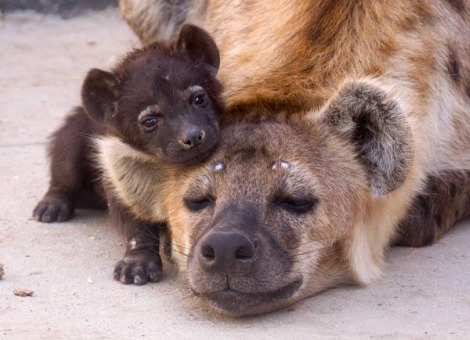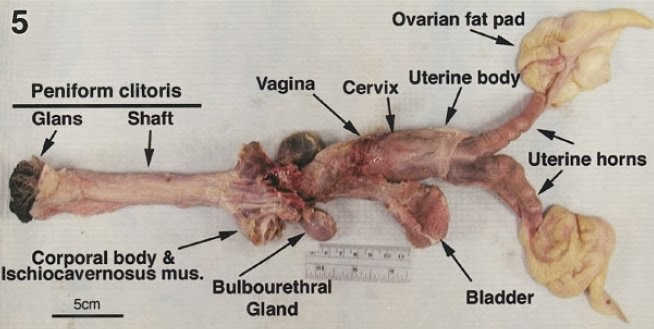 |
| This is the hyena equivalent of jumping up and down, squealing, and saying OMG OMG I MISSED YOU! |
Female spotted hyenas dealt with the issue of penis-envy by evolving pseudo-penises that can swordfight just as well as the real deal. All females have this false penis that is traversed to the tip by a central urogenital canal, which allows the female to urinate, mate, and give birth.
Let that settle in for a second. They give birth through their pseudo-dicks. Tiny tiny channel, big baby hyena.
| Oof. Suddenly this thing sounds a whole lot less fun. |
While the pseudo-dick deserves a double-take and looks almost identical to the males, this doesn't make the female hyena's any less "female." They are still genetically female, but with a clit that is 90% as long as a male penis and just as wide in diameter. The female possesses no external vagina, as the labia are fused to form a pseudo-scrotum. In the females, this scrotum consists of soft adipose tissue. Just like a penis, the enlarged hyena clitoris can become fully erectile, raising its head in hyena greeting ceremonies, social displays, games of rough and tumble or when sniffing out peers.
Not only do they have permanent she-wees, both males and females are also blessed with penile spines.Yes, little spikes on the base of the glans of their clits and dicks that make their sexual organs rough like sandpaper. Aren't you glad you're not a hyena??
Male hyenas can't actually get to lady hyena's vaginas directly because they're blocked by the false scrotum and testes. They have to go in through the enormous clitoris, which has to be retracted first. This gives females a lot more control over mating in the pack, which is why they are one of the rare groups of animals where the females are in charge. Sounds pretty ideal... except for the birth-through-a-barbed-pseudo-penis thing. That still sounds pretty shitty.
 |
| So cute, but we bet it felt less cute when it was being birthed out her pseudo-penis. |
Works Cited
Blackledge, Catherine (2003). The Story of V: A Natural History of Female Sexuality. Rutgers University Press. ISBN 978-0-8135-3455-8. Retrieved 2012-06-23.
Glickman, Stephen E.; Cunha, Gerald R.; Drea, Christine M.; Conley, Alan J.; Place, Ned J. (2006). "Mammalian sexual differentiation: lessons from the spotted hyena". Trends in Endocrinology and Metabolism 17 (9): 349-56. doi:10.1016/j.tem.2006.09.005.PMID 17010637
Kruuk, Hans (1972). The Spotted Hyena: A Study of Predation and Social Behaviour. University of Chicago Press.
Wingfield, John C (2006). "Communicative Behaviors Hormone-Behavior Interactions, and Reproduction in Vertebrates". In Neill, Jimmy D. Physiology of Reproduction 2. Gulf Professional Publishing.ISBN 978-0-12-515402-4. Retrieved 2012-11-27.
----------





No comments:
Post a Comment